The Cornell Lab Bird Academy › Discussion Groups › Nature Journaling and Field Sketching › Noticing Themes in Nature
-
 I need to practice with themes for awhile and maybe brainstorm some journal topics here. I went outside and was looking for patterns when I saw the cottontail and felt compelled to sketch it. I didn’t have much time though and I struggled with proportions, but it was fun.
I need to practice with themes for awhile and maybe brainstorm some journal topics here. I went outside and was looking for patterns when I saw the cottontail and felt compelled to sketch it. I didn’t have much time though and I struggled with proportions, but it was fun. -
 Many questions come to mind, what do they eat, do they feel the cold, do they join other flocks elsewhere. It’s a challenge to sit outside in nature due to winter weather but my backyard feeders provide me lots of movement. The house sparrows dart around in groups, the leaves are all being blown off now, patterns as they wave their final farewells. They provide part of the ecosystem with fertilizer in the spring. How many leaves are too many? This module has been really interesting, and as others have said a real help to focus and be present in nature.
Many questions come to mind, what do they eat, do they feel the cold, do they join other flocks elsewhere. It’s a challenge to sit outside in nature due to winter weather but my backyard feeders provide me lots of movement. The house sparrows dart around in groups, the leaves are all being blown off now, patterns as they wave their final farewells. They provide part of the ecosystem with fertilizer in the spring. How many leaves are too many? This module has been really interesting, and as others have said a real help to focus and be present in nature. -
After an incredibly hot summer with no rain,, I notice the change in my vegetable garden. Tiny, tiny butter nut squash!

-

-
I spent some time in my local park. The grassy areas had just been seeded, so the sprinklers were going on and off around me. I noticed the sparrows drank water from the puddles, but the grackles waited until the water shut off to walk around the grass. Do bugs crawl up out of the water? Does the freshly planted seed show up better in the wet grass? Does the wet grass feel good on their toes? I wouldn't have noticed this had I not been an intentional observer.

-
I went to the park for a walk, and looked for examples of scale, quantity and changes. I was amazed how different locations, in the park, host a different number of pine trees! Birds seem to prefer the more quite area, as they fly away when I approach carefully. Taking a close look at those pine trees, I was surprised to see different shape and size cones and realized I needed to do some research about pine trees reproductive cycle! Some questions came to my mind: why do some trees have so much more mature cones than others? Maybe the wind has influence? How long does a mature cone takes to take shape? Female cones seem to grow mostly in the upper branches; does that happen always?
-

-
I'm observing the cicadas buzzing not only cycles as a group, but increases in intensity around early evening. Also, as of the last week, the intensity of their droning has waned. A possible explanation of the buzzing could be: is it to signal a food source? is it to signal for a mate? The lessening intensity perhaps is indicating the mating season is over, the life cycle of the cicadas is coming to an end and their eggs are laid for the next cycle? The more I observe, the more I marvel at the body of knowledge that has been gained from those who've gone before me and made the observations we have now that encompass the field of biology. It also causes me to appreciate those who didn't have technology at their fingertips and had to gain knowledge of their world by observing the patterns and seasons for their very survival.
-
 Mushrooms growing in the middle of an oak tree. Themes: Scale & Quantity, Patterns, Changes.
Mushrooms growing in the middle of an oak tree. Themes: Scale & Quantity, Patterns, Changes. -
 I wander how grass and plants stay green under several centimetres of snow and ice in winter. Perhaps they have some mecanism of adaption, as birds do, but I do not know. I noticed some tiny birds stay here in winter, and their tiny feet in the ice and snow seem not to bother them.
I wander how grass and plants stay green under several centimetres of snow and ice in winter. Perhaps they have some mecanism of adaption, as birds do, but I do not know. I noticed some tiny birds stay here in winter, and their tiny feet in the ice and snow seem not to bother them.
-
Many themes, it was a challenge to decide which to work on first.


-
May, I like your page and your watercolor of the plant. I especially appreciated your very first note about it's a beautiful little plant.
-
-
There is so much to wonder about and enjoy in our world. I am inspired by the other course attendees! Please keep sharing your journals and thoughts.



-
Listening to the cicadas I was struck with how the rise and fall of the intensity/loudness seemed synchronized among the cicadas in my maple tree. Why and how do they do that? I have learned much about cicadas, but haven't answered that question yet. Still working on it.

-
Finches like to visit our feeder when it is full, but it’s always a flurry of feathers when it begins to run low, and other kinds of birds seem to visit more often when the feeder is less full. - is it that it takes them a while to remember about this easy food source? - do the other birds not want the food when the feeder is full due to the timing? - is it harder for the other birds to get on the feeder with all the finches on it? - do they want to stock up while the food is there so they won’t need it until the feeder runs low again? - all of the above?

-
This was an easy lesson for me. Often when we are traveling or hiking my husband and I will work through the process you have described here. It comes naturally to us. I created the entry below from an observation we made just the other day.

-
I always thought that the dew trapped in spiderwebs was just beautiful, I loved taking pictures of the fantastic "pearls" shining early morning. One day, as I was visiting my home Country Colombia, I started climbing a mountain with my camera looking for birds, but the amazing flora captivated me so much, the sun was rising and all the plants were covered with tiny water droplets. A few hours later, as I was heading down, it was really hot and I was so surprised to to see that even though the plants were dried, some of the spiderwebs were still completely cover with water drops, as they were at dawn.
- Perhaps silk refrigerates water and protect it from evaporation so the spider has fresh water to drink
- Maybe spiders attract insects with water in hot weather
- Water trapped in the silk takes longer to evaporate.



-
These are really beautiful (photos and drawings)!
-
I really like the way you drew and painted the water droplets. I would think that would be hard. How did you do it? If you don't mind my asking?
-
 A fallen tree with beautiful patterns and shadows as decomposition starts. Are insects making these patterns or is it just water prompted rotting?
A fallen tree with beautiful patterns and shadows as decomposition starts. Are insects making these patterns or is it just water prompted rotting? -
Flowers on shrubs attract certain insects; for example, butterflies & bees. Flowers turn into berries and the birds feed on the berries. A garden lizard (Anole) flashes his bright red gizzard to ward off other males. He is protecting his territory. Common Gallinules protect their young by keeping them close by and if they wander off the adults are always aware of their location. They show them how to find food. The young watch and learn from the adults.
-
I got to watch this little mallard family at a lake not far from my house. Although I often see mallards there I think this was the first family sighting. The ducklings stayed so tightly clustered together that they were impossible to count. I would think they stay so close for safety. I also started to wonder if staying directly behind the mama also helps cut the current making easier for them to swim (they were swimming under the dam against the current which can get pretty strong at times, I've seen a small turtle get swept away). Ps. If this posts twice I apologize, I tried posting and it read error so I re posted.

-
Love this!
-
Amazing!
-
I really like your drawing and your lovely description of the ducklings. Thanks.
-
-
 I went to observe the sand crabs - tinny creatures that will disappear with the any movement around it. So, you have to stay still for a bit more than 5 minutes for them to comeback and continue their pieces of art on the sand.
They appear when the tide is low. They are at the lowest level of the ecosystems, shore birds would eat them (I don’t know if the fishes does too but this makes me wonder where do they go when to seawater covers this area of the beach).
The create clean pretty forms in the ground with the beach sand. I was able to video several scenes while they are sucking the sand into their lower body whole then bubbling it out of their mouth creating mini-sand balls. They try to rearrange the sandballs by fixing them in lines with their back legs (Am I using the right word here?).
I went to observe the sand crabs - tinny creatures that will disappear with the any movement around it. So, you have to stay still for a bit more than 5 minutes for them to comeback and continue their pieces of art on the sand.
They appear when the tide is low. They are at the lowest level of the ecosystems, shore birds would eat them (I don’t know if the fishes does too but this makes me wonder where do they go when to seawater covers this area of the beach).
The create clean pretty forms in the ground with the beach sand. I was able to video several scenes while they are sucking the sand into their lower body whole then bubbling it out of their mouth creating mini-sand balls. They try to rearrange the sandballs by fixing them in lines with their back legs (Am I using the right word here?).
 The upper part of the page has a wide scene of the beach; the sand balls looks amazing in reality. The lower part of the page has a close-up of one of the holes , the sand balls, the prints of the sand bubbler crab and the crab (owner of this in process piece of art).
While observing, sketching and videographing, lots of unanswered questions popped into my mind. Some of which are:
1) do they “see” with their eyes or do they sense the vibrations of any movement with their whole body? (They are too fast)
2) why do they form such shapes? Does the bubbled sand-balls has some liquid or smell that comes out of them while bubbling it?
3) is this an indicator of the crab’s territory? Or a mating sign?
4) what is the lifespan of the crab ? At which age(?) do they start designing these bubbled sand ?
5) when the tide is high, and when all their sand-balls are ruins where do they go ? Why do they insist on bubbling new sand-balls over and over and never give up?
6) if they can be pray of birds - doesn’t these sand-balls are clear marks of their existence ? (Bird-view wise they can be spotted easily!)
Guess I have to research it to find answers :)
The upper part of the page has a wide scene of the beach; the sand balls looks amazing in reality. The lower part of the page has a close-up of one of the holes , the sand balls, the prints of the sand bubbler crab and the crab (owner of this in process piece of art).
While observing, sketching and videographing, lots of unanswered questions popped into my mind. Some of which are:
1) do they “see” with their eyes or do they sense the vibrations of any movement with their whole body? (They are too fast)
2) why do they form such shapes? Does the bubbled sand-balls has some liquid or smell that comes out of them while bubbling it?
3) is this an indicator of the crab’s territory? Or a mating sign?
4) what is the lifespan of the crab ? At which age(?) do they start designing these bubbled sand ?
5) when the tide is high, and when all their sand-balls are ruins where do they go ? Why do they insist on bubbling new sand-balls over and over and never give up?
6) if they can be pray of birds - doesn’t these sand-balls are clear marks of their existence ? (Bird-view wise they can be spotted easily!)
Guess I have to research it to find answers :) -
I don't understand the whole sand ball work of the crab either. I spent a day watching the crabs and birds at Pea Island last spring. Your drawings make me want to do some research. Thank you.
-
-
 I have a big patch of Siberian Iris in my backyard that is currently showing all phases of its reproductive cycle, and showing the life cycle change the flower is going through including the seedhead that is formed after pollination. The seedheads in my garden are from last year's flowers that were never deadheaded. Siberian Iris reproduce by seed and by their rhizomes spreading. The Anther is hidden under the Style arms and above the Fall (the lower petal). You really have to look for the Anther. I could not find it at first. I imagine that pollinators are enticed in by the Signal (the yellow patch) and the veining which seems to be saying "here I am...come pollinate me". I drew the central flower with a yellow glow to indicate that it is at the height of readiness for reproduction to occur, and doing all it can to communicate that readiness to creatures that can make pollination occur.
I have a big patch of Siberian Iris in my backyard that is currently showing all phases of its reproductive cycle, and showing the life cycle change the flower is going through including the seedhead that is formed after pollination. The seedheads in my garden are from last year's flowers that were never deadheaded. Siberian Iris reproduce by seed and by their rhizomes spreading. The Anther is hidden under the Style arms and above the Fall (the lower petal). You really have to look for the Anther. I could not find it at first. I imagine that pollinators are enticed in by the Signal (the yellow patch) and the veining which seems to be saying "here I am...come pollinate me". I drew the central flower with a yellow glow to indicate that it is at the height of readiness for reproduction to occur, and doing all it can to communicate that readiness to creatures that can make pollination occur.
-
Beautiful example of CHANGE happening in your garden. Your irises are so lovely, especially your drawing of the iris in full bloom. I also loved your description of the flower working so hard to entice pollinators - never quite thought of a flower’s beauty that way, as a lure for pollinators, but it makes perfect sense! Thank you for sharing this beautifully rendered, colorful, and detailed page with us.
-
Amazing! What a wonderful way to explore change. Thanks for sharing your inspiring example.
-
I love the way you used art so beautifully to illustrate the changes in the iris. I am inspired to try this with some iris in my yard next spring. Perhaps I will use hostas or astilbes this year. There is still time.
-
This is excellent. I am excited to learn to improve my art. Thanks for the inspiration.
-
Very instructive.
-
-


-
Wow these are amazing! Love the fish!
-
#journalinggoals these are brilliant!
-
Beautiful style. Inspiration.
-
Amazing moss drawing! Such detail
-
-



-
Wow 😯! I love all the details, writing ✍️, & drawing that you have put into your journal 📔 pages. Very interesting, informative and colorful. I hope to eventually get mine like that.
-
Leonora, I really can't believe how gorgeous each of these pages are. The drawing is just inspirational and the information adds a whole other dimension to each page. The way you have arranged each page is so pretty and cohesive. Really really lovely!
-
Love the prickly pear cactus especially.
-
-


 Yes I noticed the scale, quantity, and patterns of the cherry blossoms 🌸 on the branch my husband brought in this past March.
Yes I noticed the scale, quantity, and patterns of the cherry blossoms 🌸 on the branch my husband brought in this past March.
-
I have been doing post sunrise walk along a meadow facing the woods. The Stars of Bethlehem in the tall grasses are starting to open again from their green striped like close umbrella overnights. The spittle bugs are busy already. I looked up their life cycle because I did not know they(the nymphs) have to come up for air in the spittle!

Read More:
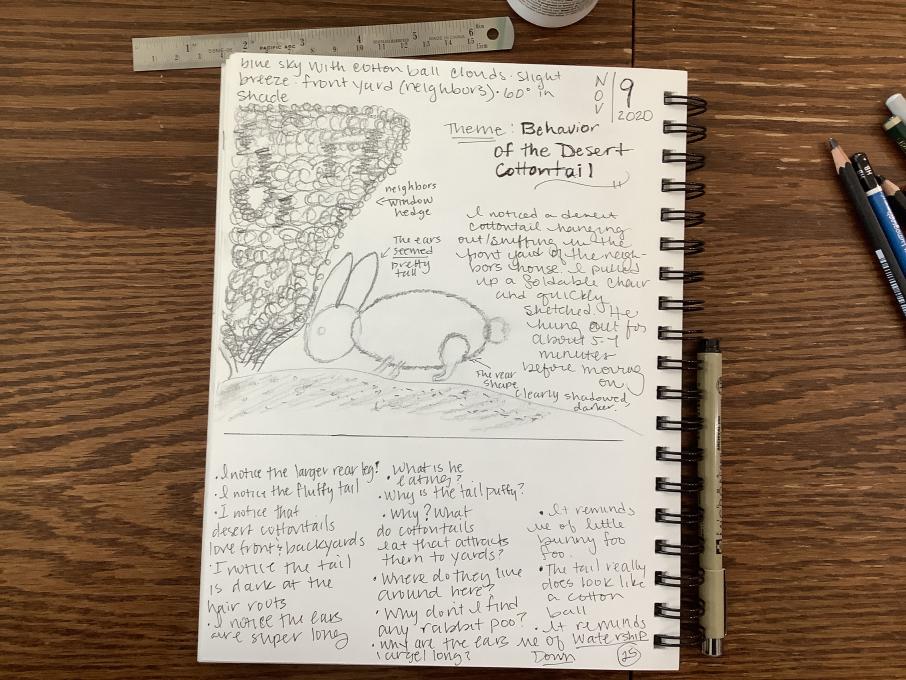 I need to practice with themes for awhile and maybe brainstorm some journal topics here. I went outside and was looking for patterns when I saw the cottontail and felt compelled to sketch it. I didn’t have much time though and I struggled with proportions, but it was fun.
I need to practice with themes for awhile and maybe brainstorm some journal topics here. I went outside and was looking for patterns when I saw the cottontail and felt compelled to sketch it. I didn’t have much time though and I struggled with proportions, but it was fun.  Many questions come to mind, what do they eat, do they feel the cold, do they join other flocks elsewhere. It’s a challenge to sit outside in nature due to winter weather but my backyard feeders provide me lots of movement. The house sparrows dart around in groups, the leaves are all being blown off now, patterns as they wave their final farewells. They provide part of the ecosystem with fertilizer in the spring. How many leaves are too many? This module has been really interesting, and as others have said a real help to focus and be present in nature.
Many questions come to mind, what do they eat, do they feel the cold, do they join other flocks elsewhere. It’s a challenge to sit outside in nature due to winter weather but my backyard feeders provide me lots of movement. The house sparrows dart around in groups, the leaves are all being blown off now, patterns as they wave their final farewells. They provide part of the ecosystem with fertilizer in the spring. How many leaves are too many? This module has been really interesting, and as others have said a real help to focus and be present in nature. 



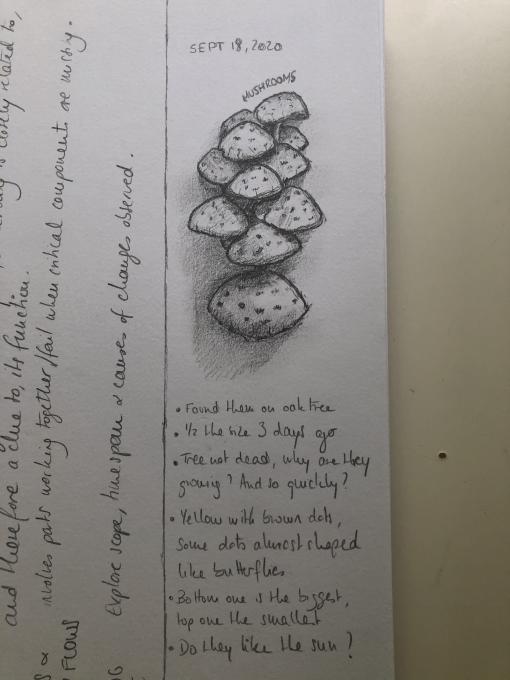 Mushrooms growing in the middle of an oak tree. Themes: Scale & Quantity, Patterns, Changes.
Mushrooms growing in the middle of an oak tree. Themes: Scale & Quantity, Patterns, Changes.  I wander how grass and plants stay green under several centimetres of snow and ice in winter. Perhaps they have some mecanism of adaption, as birds do, but I do not know. I noticed some tiny birds stay here in winter, and their tiny feet in the ice and snow seem not to bother them.
I wander how grass and plants stay green under several centimetres of snow and ice in winter. Perhaps they have some mecanism of adaption, as birds do, but I do not know. I noticed some tiny birds stay here in winter, and their tiny feet in the ice and snow seem not to bother them.
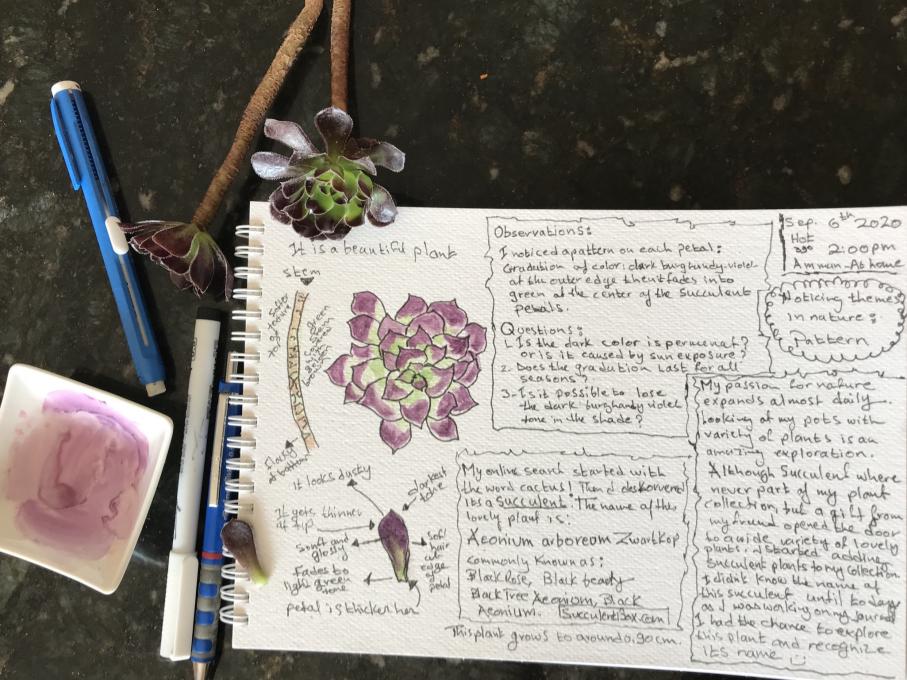
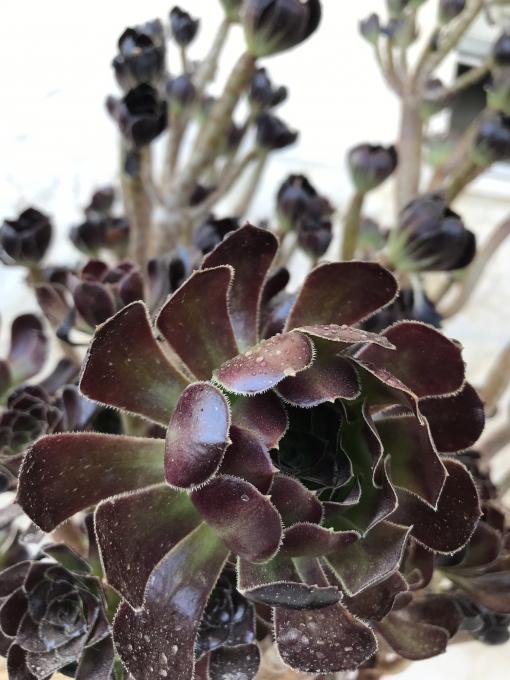
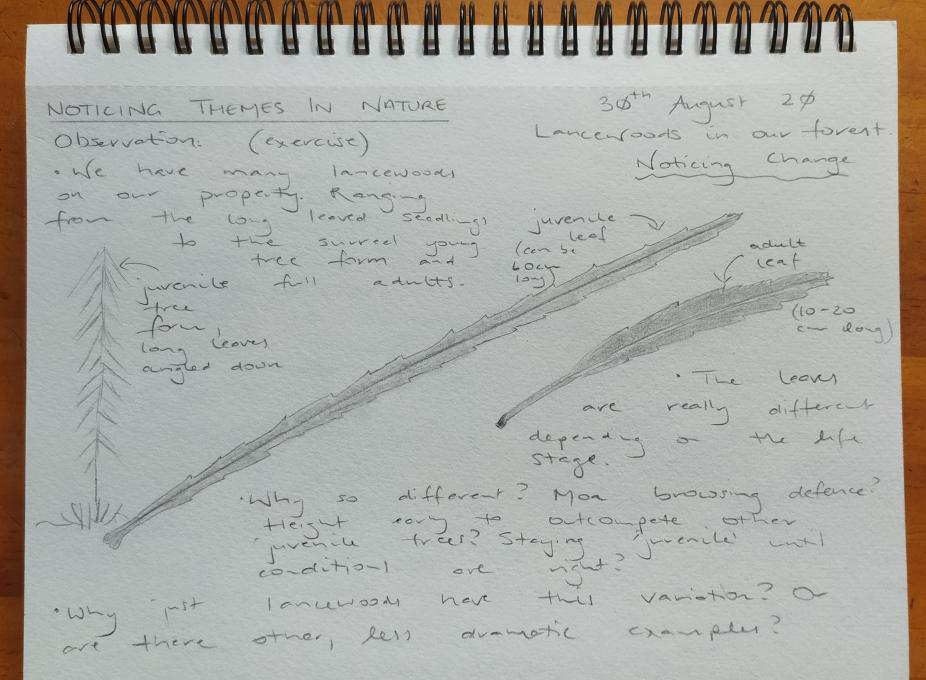
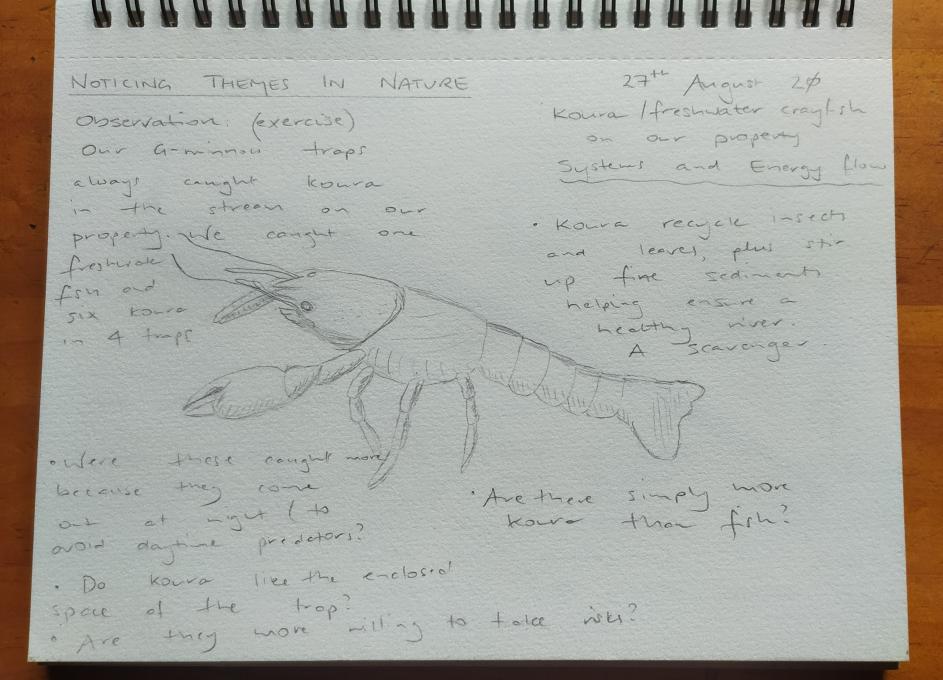
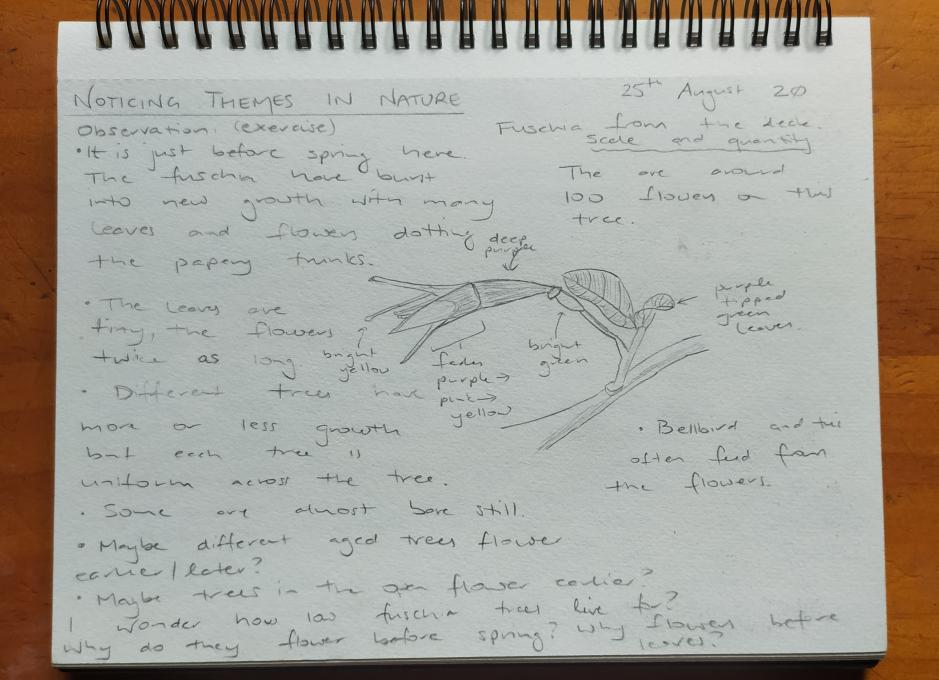
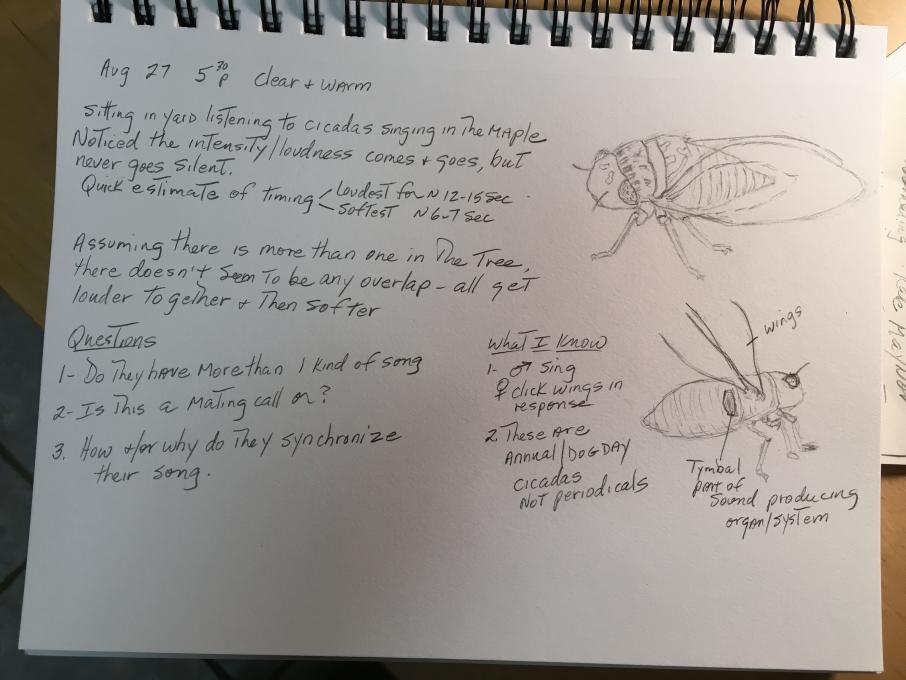
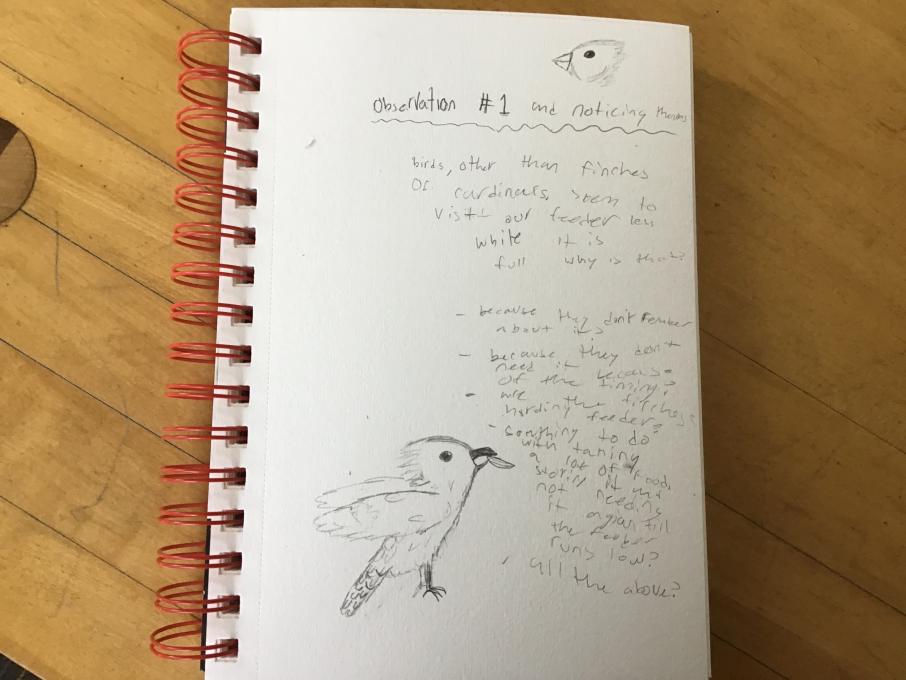

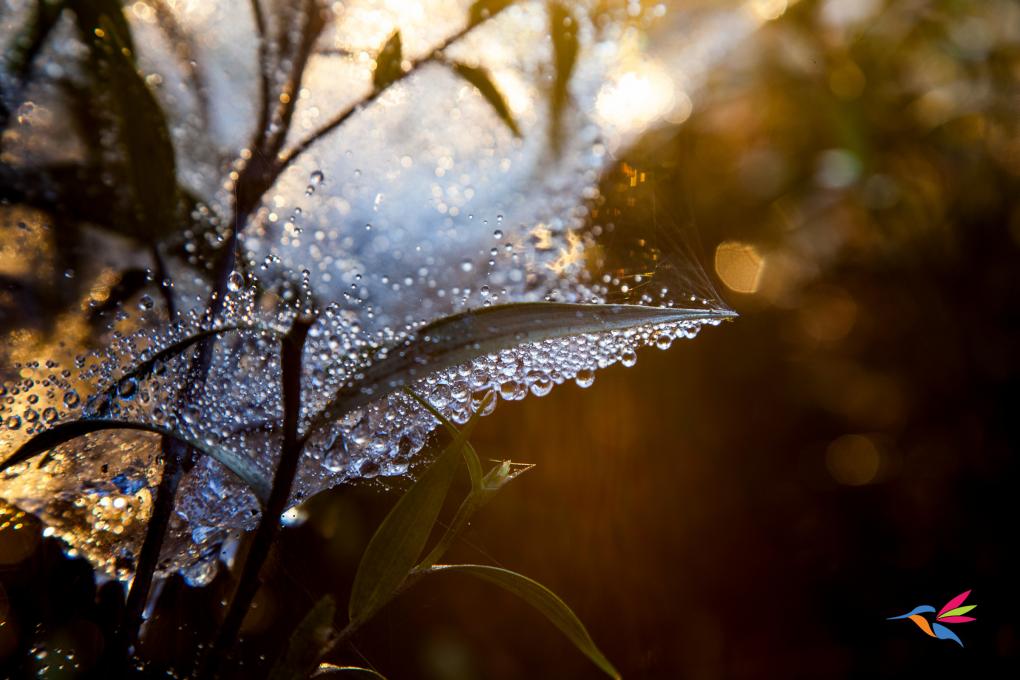
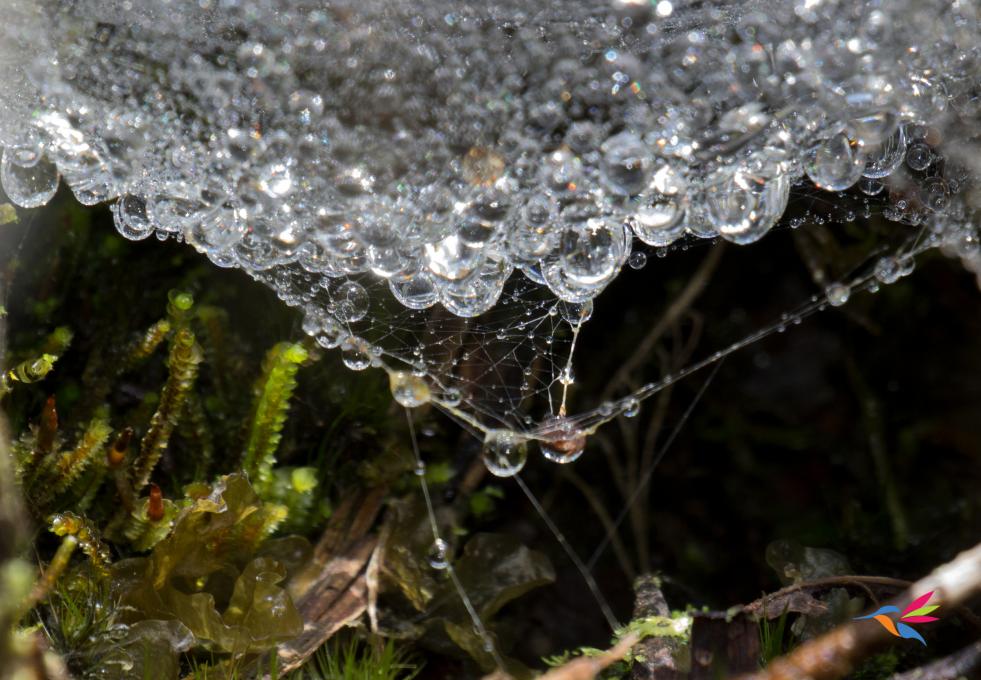
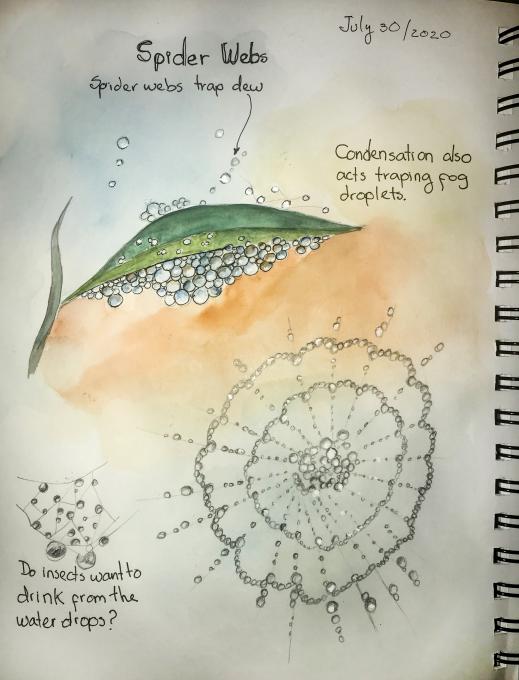
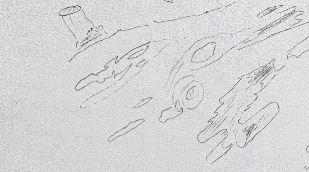 A fallen tree with beautiful patterns and shadows as decomposition starts. Are insects making these patterns or is it just water prompted rotting?
A fallen tree with beautiful patterns and shadows as decomposition starts. Are insects making these patterns or is it just water prompted rotting? 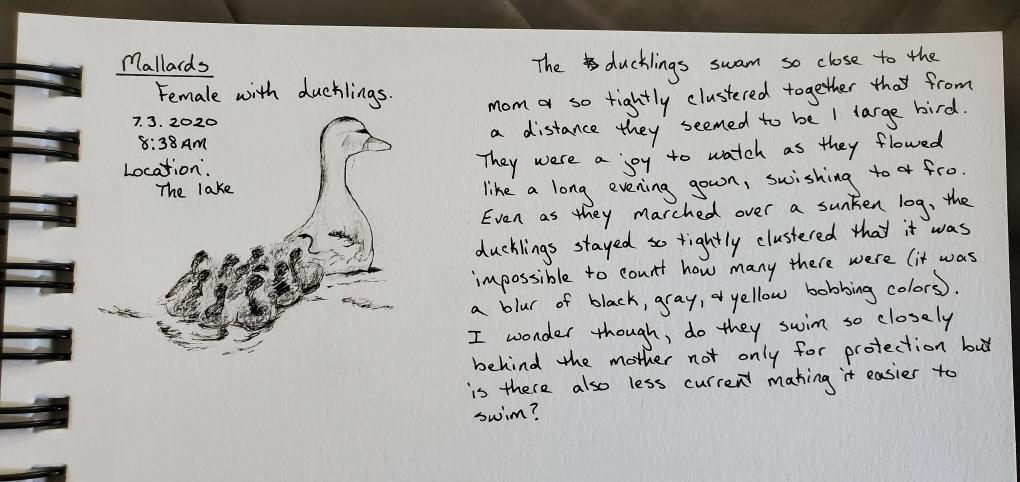
 I went to observe the sand crabs - tinny creatures that will disappear with the any movement around it. So, you have to stay still for a bit more than 5 minutes for them to comeback and continue their pieces of art on the sand.
They appear when the tide is low. They are at the lowest level of the ecosystems, shore birds would eat them (I don’t know if the fishes does too but this makes me wonder where do they go when to seawater covers this area of the beach).
The create clean pretty forms in the ground with the beach sand. I was able to video several scenes while they are sucking the sand into their lower body whole then bubbling it out of their mouth creating mini-sand balls. They try to rearrange the sandballs by fixing them in lines with their back legs (Am I using the right word here?).
I went to observe the sand crabs - tinny creatures that will disappear with the any movement around it. So, you have to stay still for a bit more than 5 minutes for them to comeback and continue their pieces of art on the sand.
They appear when the tide is low. They are at the lowest level of the ecosystems, shore birds would eat them (I don’t know if the fishes does too but this makes me wonder where do they go when to seawater covers this area of the beach).
The create clean pretty forms in the ground with the beach sand. I was able to video several scenes while they are sucking the sand into their lower body whole then bubbling it out of their mouth creating mini-sand balls. They try to rearrange the sandballs by fixing them in lines with their back legs (Am I using the right word here?).
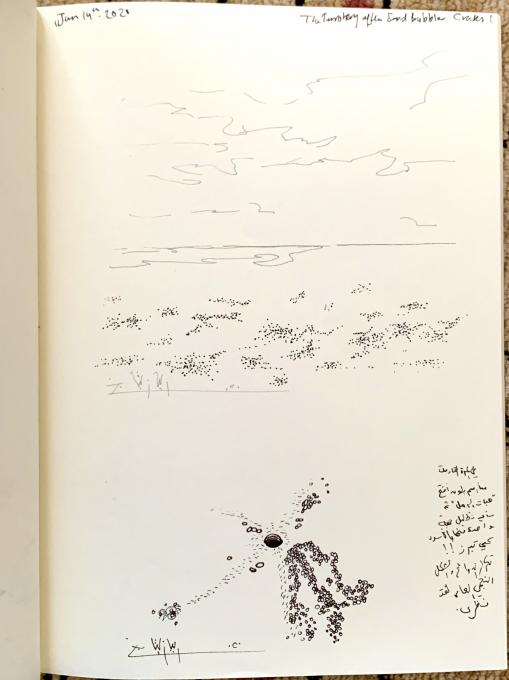 The upper part of the page has a wide scene of the beach; the sand balls looks amazing in reality. The lower part of the page has a close-up of one of the holes , the sand balls, the prints of the sand bubbler crab and the crab (owner of this in process piece of art).
While observing, sketching and videographing, lots of unanswered questions popped into my mind. Some of which are:
1) do they “see” with their eyes or do they sense the vibrations of any movement with their whole body? (They are too fast)
2) why do they form such shapes? Does the bubbled sand-balls has some liquid or smell that comes out of them while bubbling it?
3) is this an indicator of the crab’s territory? Or a mating sign?
4) what is the lifespan of the crab ? At which age(?) do they start designing these bubbled sand ?
5) when the tide is high, and when all their sand-balls are ruins where do they go ? Why do they insist on bubbling new sand-balls over and over and never give up?
6) if they can be pray of birds - doesn’t these sand-balls are clear marks of their existence ? (Bird-view wise they can be spotted easily!)
Guess I have to research it to find answers :)
The upper part of the page has a wide scene of the beach; the sand balls looks amazing in reality. The lower part of the page has a close-up of one of the holes , the sand balls, the prints of the sand bubbler crab and the crab (owner of this in process piece of art).
While observing, sketching and videographing, lots of unanswered questions popped into my mind. Some of which are:
1) do they “see” with their eyes or do they sense the vibrations of any movement with their whole body? (They are too fast)
2) why do they form such shapes? Does the bubbled sand-balls has some liquid or smell that comes out of them while bubbling it?
3) is this an indicator of the crab’s territory? Or a mating sign?
4) what is the lifespan of the crab ? At which age(?) do they start designing these bubbled sand ?
5) when the tide is high, and when all their sand-balls are ruins where do they go ? Why do they insist on bubbling new sand-balls over and over and never give up?
6) if they can be pray of birds - doesn’t these sand-balls are clear marks of their existence ? (Bird-view wise they can be spotted easily!)
Guess I have to research it to find answers :) 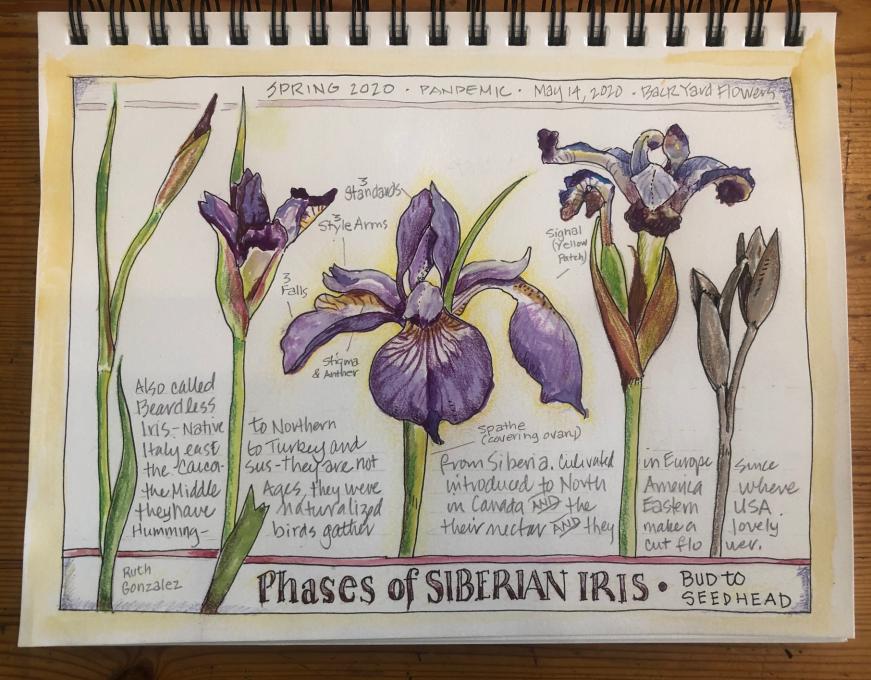 I have a big patch of Siberian Iris in my backyard that is currently showing all phases of its reproductive cycle, and showing the life cycle change the flower is going through including the seedhead that is formed after pollination. The seedheads in my garden are from last year's flowers that were never deadheaded. Siberian Iris reproduce by seed and by their rhizomes spreading. The Anther is hidden under the Style arms and above the Fall (the lower petal). You really have to look for the Anther. I could not find it at first. I imagine that pollinators are enticed in by the Signal (the yellow patch) and the veining which seems to be saying "here I am...come pollinate me". I drew the central flower with a yellow glow to indicate that it is at the height of readiness for reproduction to occur, and doing all it can to communicate that readiness to creatures that can make pollination occur.
I have a big patch of Siberian Iris in my backyard that is currently showing all phases of its reproductive cycle, and showing the life cycle change the flower is going through including the seedhead that is formed after pollination. The seedheads in my garden are from last year's flowers that were never deadheaded. Siberian Iris reproduce by seed and by their rhizomes spreading. The Anther is hidden under the Style arms and above the Fall (the lower petal). You really have to look for the Anther. I could not find it at first. I imagine that pollinators are enticed in by the Signal (the yellow patch) and the veining which seems to be saying "here I am...come pollinate me". I drew the central flower with a yellow glow to indicate that it is at the height of readiness for reproduction to occur, and doing all it can to communicate that readiness to creatures that can make pollination occur.
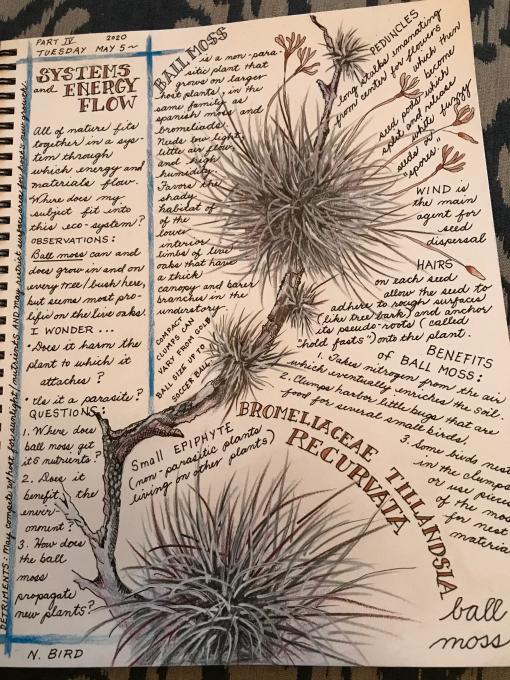
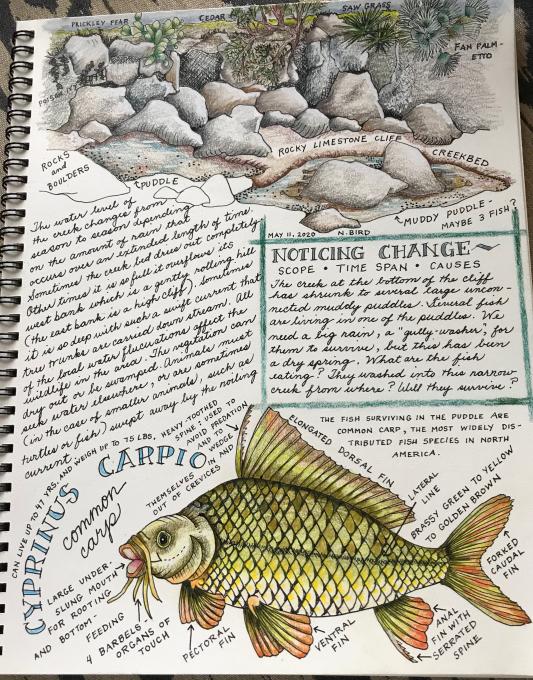
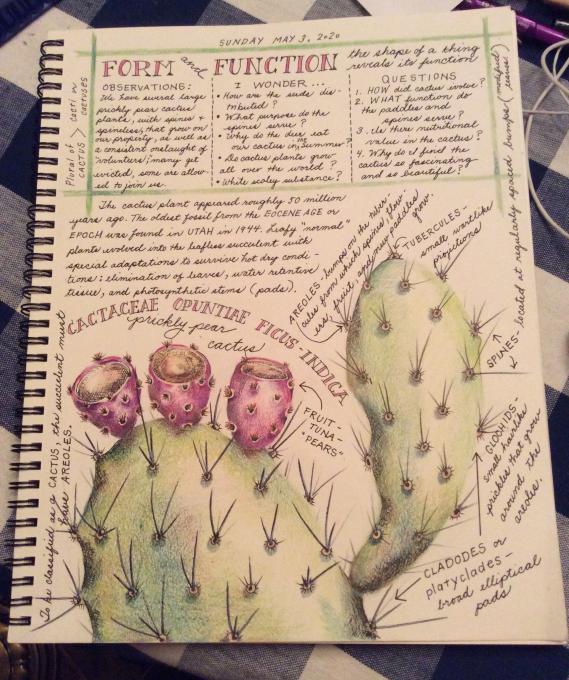
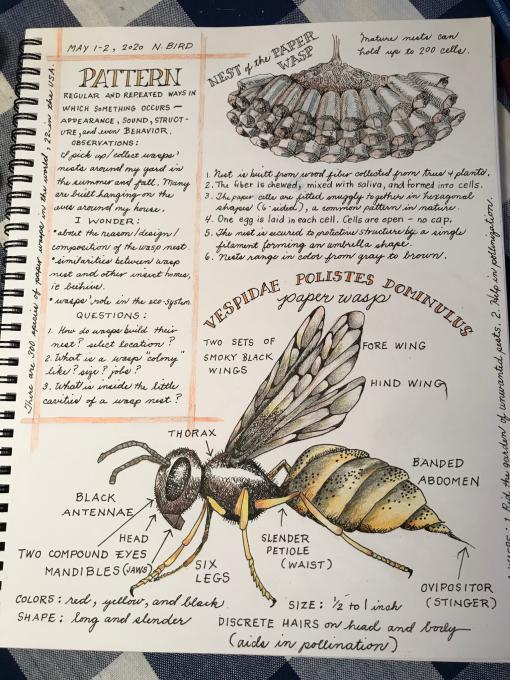



 Yes I noticed the scale, quantity, and patterns of the cherry blossoms 🌸 on the branch my husband brought in this past March.
Yes I noticed the scale, quantity, and patterns of the cherry blossoms 🌸 on the branch my husband brought in this past March.